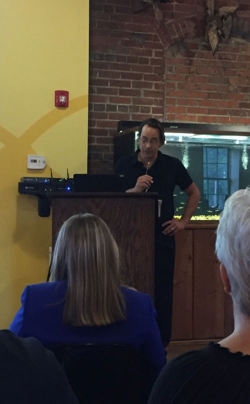Plant Hammond’s pollution of Coosa River draws community outcry
The Georgia Environmental Protection Division held a well-attended public hearing last night about a new draft water discharge permit for Georgia Power’s Plant Hammond. More than a dozen locals got up to speak about how the lax permit would be ineffective in countering the coal-fired power plant’s harmful impacts on the Coosa River, Floyd County, and other surrounding communities.
Located in Rome, Ga., the plant sits on the banks of the Coosa River near the Georgia-Alabama border. Citizens from both states attended the hearing and expressed concerns for the health of the river and the glaring lack of protections in the permit to preserve it for current and future generations.
It breaks my heart to know that if action is not taken to protect our water, that such beauty and enjoyment will be lost,” said Angela Greear, a local resident. “Water is a finite resource, and once gone will never return.
Expired since 2012, Plant Hammond’s wastewater discharge (NPDES) permit is long overdue. On behalf of Sierra Club and the Coosa River Basin Initiative, SELC submitted detailed written comments today on the draft permit, which falls short in a number of ways.
The state’s draft permit puts no limits on Hammond’s discharges of toxic metals, such as mercury and arsenic, into the Coosa. New federal rules require that the plant reduce these discharges by November 2018, but the permit gives Georgia Power until 2023 to comply with these critical protections.
Joe Cook of the Coosa River Basin Association asks the state to better protect clean water when renewing an expired wastewater discharge permit for Georgia Power’s Plant Hammond.
Locals ask for better
Plant Hammond lacks a cooling tower, and the draft permit would allow the plant to continue pumping heated cooling water into the Coosa River. The Coosa River earned a spot on the Georgia Water Coalition’s 2016 Dirty Dozen list as a result of the degradation caused by superheated wastewater discharges from Plant Hammond.
For decades, Plant Hammond has used the Coosa River in effect as the treatment system for its thermal pollution,” said SELC Senior Attorney, Kurt Ebersbach. “This permit would allow it to continue to claim an unreasonably large swath of the river as a ‘sacrifice zone’ for this thermal waste.
Plant Hammond’s outdated cooling water technology also withdraws 600 million gallons of water from the Coosa River each day. As a result, 30,000 to 60,000 fish are killed annually after getting sucked into Plant Hammond’s pipes or pinned against the facility’s water intake screens.
Despite this tremendous impact on the Coosa River fishery, EPD’S proposed permit for Plant Hammond fails to address federal requirements to eliminate these fish deaths,” said Joe Cook, Advocacy and Communication Coordinator for the Coosa River Basin Initiative. “The impact of some 60 years of fish deaths at Plant Hammond cannot be measured, but undoubtedly, the cumulative effect of the plant has reduced the quantity and diversity of fish in this river system.
These sentiments were reiterated by comments throughout the public hearing.
Action on this permit is already long overdue,” said Ian Karra, the Sierra Club’s organizing representative for the Beyond Coal campaign in Georgia. “It’s unacceptable to consider leaving the Coosa and Floyd County residents unprotected from toxic wastewater and pollutants even longer.
